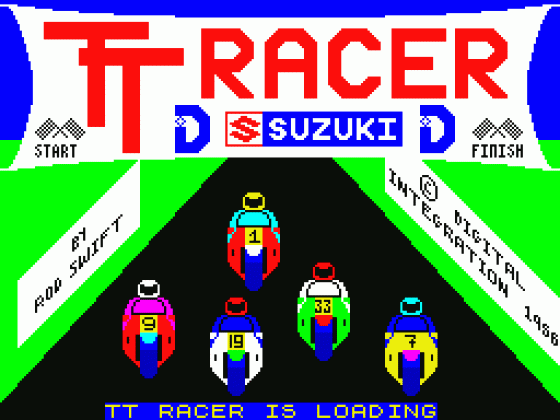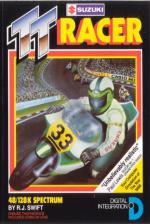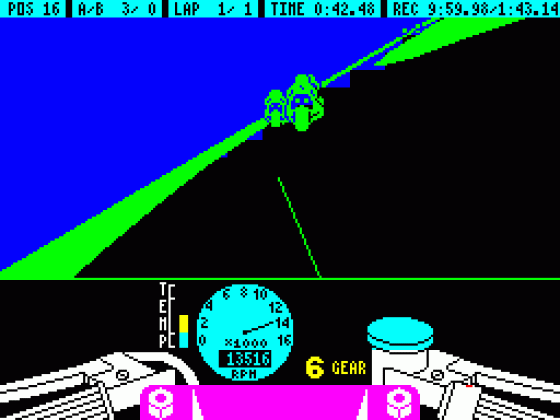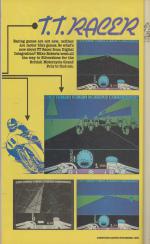
Computer Gamer
 1st November 1986
1st November 1986
Categories: Review: Software
Publisher: Digital Integration
Machine: Spectrum 48K
Published in Computer Gamer #20
Racing games are not new; neither are motor bike games. So what's new about TT Racer from Digital Integration? Mike Roberts went all the way to Silverstone for the British Motorcycle Grand Prix to find out.
TT Racer
Digital Integration are well known for their exciting and accurate simulation programs with hits such as Tomahawk and Fighter Pilot. They previously had a motor cycle game called Speed King which has just been re-released by Mastertronic. TT Racer however is the result of a collaboration with the Heron-Suzuki team over a period of two years in an attempt to produce as accurate a simulation of motor cycle racing as possible. Is this the two-wheeled answer to Revs? Possible - but read on anyway.
TT Racer comes with the now notorious Lenslok system, which renders most games unloadable unless you have acute myopia, and reduces piracy by the same amount that a very stern copyright message does. But Digital Integration seem to be dedicated to it, so I suppose we'll have to live with it.
Also in the double size cassette box is a colourful manual with lots of information in it about the bikes, the riders, the tracks, and the races - complete with the track records for all the various sizes of engine. The relevant information for the game is also well presented with colour pictures and diagrams with colour pictures and diagrams of the screen layout and hints on racing technique.

The game itself starts on the right foot with an option screen full of every conceivable twiddle. Four engine sizes are catered for (80, 125, 250, 500ccs). Club, National, European and Grand Prix rules are selectable. This changes the skill level of the opposition and affects the handling of the bike to a certain extent.
There are twelve different tracks to switch between, covering most of the 1986 Grand Prix series. This included Silverstone, Hockenheim and Monza.
The number of laps is also alterable, as are the controls (keyboard, Kempston, etc, etc). But the most interesting set of options is that which enables up to eight riders to compete against each other at the same time via networked Interface 1s.
To manage this, you have to give each terminal a number and nominate a master controller, as well as telling it how many external bikes are on the circuit. Then when you race, some of the computer-controlled bikes aren't there.
When you have worked out all the options, it's time to practise. This is where you can try to improve your lap time and thus improve your grid position. You can also work out the configuration of the bike. This configuration section lets you alter the six gear ratios, steering speed, tyre compound, allows you to select automatic gear change, and lets you change between road and track racing.
The main difference between these two options is that in road racing mode you get wing mirrors, a speedo, tyre wear indicators, and a fuel gauge. In track racing mode, you are limited to a tacho and a temperature gauge, with a gear indicator to keep you company. These instruments are also available on the road racing dashboard.
The organization of the screen and the dashboard is very well thought out. The lower third is the view of the bike that you would see if you were actually sitting on it, complete with a section of the fuel tank with the Suzuki logo on it. A section of the handlebars is also visible and when you use the clutch, brakes, or accelerator, these controls actually move in the appropriate manner.
The rest of the screen is dedicated to the 3D display of the track. This shows the track receding off into the distance, and the surprisingly detailed opposing bikers, as well as the scenery, grandstands and pits area. The most realistic thing about the game is the way that the bike leans around the corners with the horizon lurching to one side.
The screen update rate is four frames a second which isn't extremely fast, but is about the minimum that you could expect to get away with without the screen looking too jerky. As far as playing the game goes, it is extremely realistic, this was proved when watching bikers play the game, Paul Lewis the person endorsing the game - had never played it before, or any computer game before, but after a few minutes to get used to the control he was completely thrashing hardened games players. When a simulation game needs the skills pertaining to the activity being simulated to play it properly, then you can be sure that it's accurate.
It is this accuracy that may be the downfall of the game, Revs is an excellent racing simulation: completely accurate, and absorbing if you are used to racing. I've driven Formula Ford racing cars so the game appealed to me. However Pole Position, or Pitstop II, will always be more popular because they are games, and fun to play.
Whilst TT Racer is good for an experienced biker to play, the person who has not ridden a bike any great amount will initially have great trouble playing the game. This is where games like Speed King, Super Cycle and Full Throttle win out in that they are great to play with only the minimum amount of accuracy to detract from the gameplay.
As far as recommending this game goes, it is excellently presented, well put together, and marvellously programmed, if you are a bike fanatic, then I couldn't recommend this game more. However, if you just want a motorbike game then I suggest that you at least look elsewhere first.
Other Reviews Of TT Racer For The Spectrum 48K
TT Racer (Digital Integration)
A review by (Crash)
TT Racer (Digital Integration)
A review by Tommy Nash (Your Sinclair)
TT Racer (Digital Interaction)
A review by Graham Taylor (Sinclair User)
TT Racer (Digital Integration)
A review
This article was converted to a web page from the following pages of Computer Gamer #20.
Scores
Spectrum 48K Version| Graphics | 100% |
| Sound | 40% |
| Addictiveness | 60% |
| Friendliness | 40% |
| Overall | 60% |





